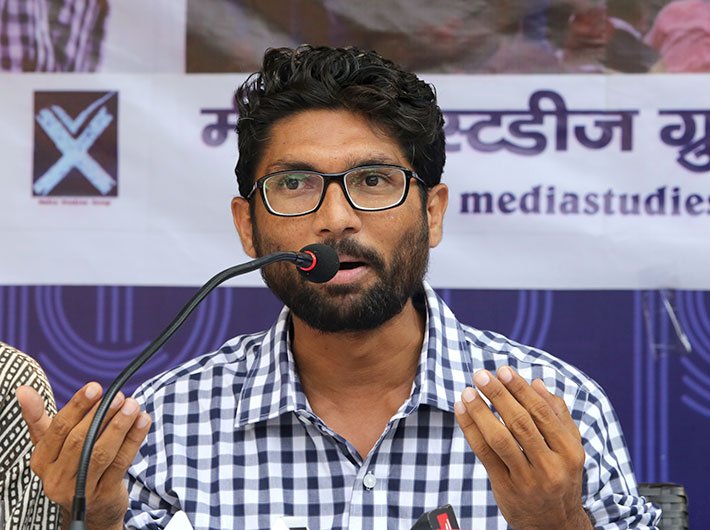When a group of upper-caste ‘cow protection’ vigilantes flogged four dalits for skinning a dead cow (and went on to even record a video clipping of the beating) in Mota Samadhiyala village near Una town of Saurashtra on July 11, it triggered an impromptu reaction across the state, now turned into an agitation led by Jignesh Mevani, a 35-year-old journalist-turned-social activist. The widespread resentment fuelling this agitation even proved the immediate reason for chief minister Anandiben Patel’s resignation. Mevani spoke with Governance Now on August 20 about this campaign:
You claim the dalit agitation this time is different. How and why?
This is not your typical ‘dalit agitation’. We are taking both caste and class together. The level of response the movement has got so far shows that you have to raise economic questions along with the demand for social justice.
Why did dalits come out on streets this way – unlike in the past cases of atrocities?
During the 12 years of Narendra Modi’s rule, 14,500 incidents of atrocities against dalits were recorded. There are 55,000 people who are still employed in manual scavenging. Untouchability is prevalent in 1,590 villages. The rate of conviction in SC atrocity cases is just 3 percent…these figures are from government reports, RTI replies, and NGOs’ field surveys.
Now Modi says, ‘Don’t shoot dalits, shoot me first’, but he did not even visit the families of the victims of the Thangadh police shootout in September 2012, when he was merely 17 km away from the spot for his election rally. [During the annual fair at pottery town of Thangadh in Surendranagar district that year, upper castes and lower castes groups came to fisticuffs over stall allocations, and both went to police with their versions. On September 22 and 23, police fired – as Mevani claims, from AK47s, no less – on a group of dalit youths, killing three.]
Four years later, the crime investigation department (CID) of the state police have refused to convert two of the three FIRs into charge-sheets. So, you can understand what we can expect from the CID probe Anandiben Patel ordered into the Una incident.
It is these long-pending grievances of the dalits that have given momentum to the state-wide agitation.
After your march from Ahmedabad to Una, at the culminating rally on August 15, you made ten demands, including allocation of five acres of land to every dalit family in the state as a form of redressal of pending problems and as a means of livelihood. Is that even feasible? Does the state government have such a massive land pool?
It is feasible, practical and viable. Indeed, there is a provision for this in the revenue law. There are waste swathes of wastelands. The government can resort to the land ceiling law. Then there are 50,000 acres of land donated under the Bhoodan movement which are yet to be allocated. Still, if needed, the government can buy land and give it to Dalits; there is a provision in the SC/ST sub-plan. The point is, if the Gujarat government can give away so much land to the Ambanis and Adanis, why not to dalits?
You say you are not a typical dalit activist. How?
You see, I am not a typical dalit activist. I am looking at dalit-Muslim unity. I have worked on farmers’ problems. I am raising economic questions. I want to make this movement inclusive – and that is one reason why some dalit groups of Gujarat have been critical of me. But the dalit movement is coming out of the old rhetoric.
Why did you quit the Aam Aadmi Party (AAP)?
Let me clarify that the AAP has never ever tried to politicise the current movement, but I am quitting so that the movement does not suffer due to my association with it.
As Gujarat next year goes to polls in which the BJP is on a weak ground for once after two decades, will the dalit movement make any impact on the results?
I don’t rule out the possibility. It will hurt the BJP the most.
But weren’t dalits harassed during the Congress rule?
Yes, but more so under the BJP rule.
What has been the response of the urban, upper-caste middle class to your movement?
Their biggest support is that they have not opposed us so far. The Patidar community [also on agitation path demanding quota] has expressed support to our movement.
You have said this is a movement that cannot fail. Will you explain that?
In the July Mahasammelan, 50,000 dalits pledged not to do the lowly menial work. Isn’t that an achievement? For some families, skinning dead animals was a business worth Rs 1.5-2 lakh a month. They have quit it. People everywhere in the state are responding enthusiastically to our slogan: Gay ki doom aap rakho, hame hamari jamin do – you [the Sangh] keep the tail of the cow, give us our land. Modi in his book ‘Karmayog’ speaks of spiritual experience dalits must be having doing the lowly work. Now, we have stopped lifting dead animals, and I invite Modi to partake the spiritual experience.
What next?
If the state government does not respond to our demands by September 15, we will launch Rail Roko agitation. We are prepared to go to jail. We will also launch a farmers agitation against it. In the days to come, we will expand this agitation to include all the marginalised.

